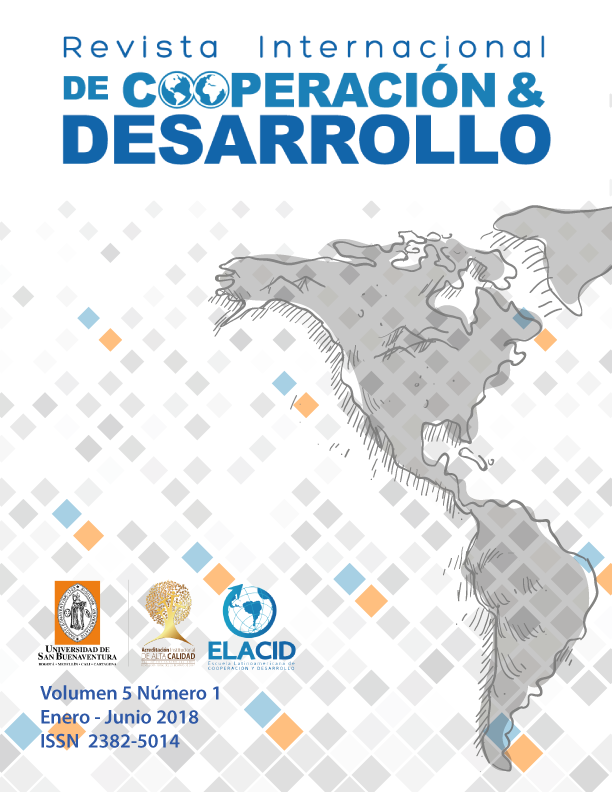INTERNATIONAL JOURNAL OF COOPERATION AND DEVELOPMENT
Assignment of Rights
Authorization for reproduction, publication, communication and distribution of a literary, artistic or scientific
Work.
I , ____________________________________________, author of the book and / or article , of legal age , resident of the city of _________________ , identified with citizenship / passport n° ______________________ issued on _______________________, in exercise of his physical and mental faculties , part henceforth be called the AUTHOR , supports the following authorization to the reproduction, publication, communication and distribution of a work, perform the following terms:
1. Regardless of current legal regulations due to the linking of the parties to this contract, and any kind of legal presumption , the parties agree that the AUTHOR authorize ( name of the publisher ) to reproduce , publish , communicate and distribute the material referred to in the International Journal of Cooperation and Development of the University of San Buenaventura.
2. Such authorization lies in particular on the copyright of the work, by any means known or unknown, publication of the work, distribution of the work , either directly or through third parties for purely educational purposes.
3. AUTHOR agrees to report and declare the existence of this authorization and to preserve the right of the International Journal of Cooperation and Development of the first publication of the work.
4. AUTHOR declares that the article is original and that it is his sole creation, no impediment of any kind exist for the authorization he is doing, besides being responsible for any action claim, plagiarism or other type of claim that might arise about .
5. Such permission is free of charge.
6. Moral copyright in the article are solely the AUTHOR and the University of San Buenaventura expressly agrees to recognize and respect them rigorously.
The Author and / or AUTHORS
SIGNATURE
Abstract
Tradicionalmente los desastres naturales han sido considerados un fenómeno neutro desde la perspectiva de género. Sin embargo, desde la década de los noventa del siglo xx aparecen investigaciones que han puesto de manifiesto que las desigualdades de género, interactuando con otros factores, aumentan la vulnerabilidad de las mujeres ante catástrofes naturales. La finalidad de este artículo es analizar si se ha incorporado y cómo la perspectiva de género en la gestión del riesgo de desastres en los Objetivos de Desarrollo del Milenio (ODM) y en los Objetivos de Desarrollo Sostenible (ODS), en tanto que ambos documentos marcan la agenda mundial en el ámbito del desarrollo desde comienzos del siglo xxi. Las conclusiones indican que las cuestiones de género y gestión del riesgo de desastres aparecen formuladas de forma más clara en los ODS, mostrando una evolución entre ambos textos.
References
Alston, M. (2014). Gender mainstreaming and climate change. Women’s Studies International Forum, 47, 287-294.
Anderson, M. B. (1994). Understanding the disaster-deveIopment continuum. Gender analysis is the essential tool. Focus on Gender, 2(1), 7-10.
Arenas Ferriz, Á. (2001). The relevance of considering a gender perspective in damage assessment and recovery strategies. A case of study in El Salvador, Central América (Expert Group Meeting on «Enviromental management and mitigation of natural disasters: a gender perspective».). Ankara, Turkey: Naciones Unidas.
Bidegain Ponte, N. (2017). La agenda 2030 y la agenda regional de género. Sinergias para la igualdad en América Latina y el Caribe. Santiago de Chile: Naciones Unidas - CEPAL.
Boserup, E. (1970). La mujer y el desarrollo económico. Madrid: Minerva ediciones.
Bradshaw, S. (2004). Socio-economic impacts of natural disasters: a gender analysis. Santiago de Chile: CEPAL, Sustainable Development and Human Settlements Division. Recuperado de http://www.cepal.org/publicaciones/UnidadMujer/8/LCL2128/lcl2128i.pdf
Bradshaw, S. (2014). Engendering development and disasters. Disasters, 39(1), 54-75.
Bradshaw, S. y Fordham, M. (2013). Women, girls and disasters. A review for DFID. Middlesex University and Northumbria University and Gender Disaster Network.
Clemens, P., Hietala, J.R., Rytter, M., Schimidt, R. y Reese, D. (1999). Risk of domestic violence after flood impact: effects of social support, age, and history of domestic violence. Applied Behavioral Science Review, 7(2), 199-206.
Cruz, C. de la (2015). Cambio, poder y justicia de género en la Agenda 2030: reflexiones para no perdernos en el camino. ICEI Policypapers Nº 1, p.1.
De Sousa, D. (1995). Sequía, migración y vivienda. ¿Dónde queda la mujer invisible? Desastres y Sociedad, 5, 125-137.
Dema Moreno, S. y Fernández Saavedra, A. G. (2016). La inclusión de la perspectiva de género en la gestión del riesgo ante desastres naturales. Marco institucional internacional y regional para América Latina y El Caribe. Comunicación presentada en el IV Congreso Internacional de Cooperación al Desarrollo “Género y Desarrollo”, Universidad Jaume I, noviembre de 2016 (Mimeo).
Elson, D. (Ed.) (1995). Male bias in the development process. Manchester y New York: Manchester University Press.
Enarson, E. (1999). Violence against women in disasters. A study of Domestic violence. Violence against Women. 5(7), 742-768.
Enarson, E. (2001). Gender equality: environmental management and natural disaster mitigation (Expert group meeting on «Enviromental managment and the mitigation of natural disasters: a gender perspective»). Ankara, Turkey: Naciones Unidas.
Enarson, E. (2012). Women confronting natural disaster: from vulnerability to resilience. Boulder, Colo: Lynne Rienner Publishers.
Enarson, E. y Meyreles, L. (2004). International perspectives on gender and disaster: differences and possibilities. International Journal of Sociology and Social Policy, 24(10/11), 49-93. https://doi.org/10.1108/01443330410791064
Enarson, E. y Scanlon, J. (1999). Gender patterns in flood evacuation: a case study in Canada’s Red River Valley. Applied Behavioral Science Review. 7(2), 103-124.
Faas, A. J., Jones, E., Whiteford, L., Tobin, G., y Murphy, A. (2014). Gendered Access to Formal and Informal Resources in Postdisaster Development in the Ecuadorian Andes. Mountain Research and Development. 34(3), 223-234. https://goo.gl/iQHTa3
Fisher, S. (2010). Violence Against Women and Natural Disasters: Findings From Post-Tsunami Sri Lanka. Violence Against Women. 16(8), 902-918. https://goo.gl/EDSjUf
Fothergill, A. (1996). Gender, Risk, and Disaster. International Journal of Mass Emergencies and Disasters. 14(1), 33-56.
Gibbs, S. L. (1990). Women’s role in the Red Cross/Red Crescent. Geneva: Henry Dunant Institute.
Grupo de Estudios de Relaciones Internacionales (GERI). (2015). Entre los ODM y los ODS: el camino a las metas globales de desarrollo sostenible. Relaciones Internacionales, (28), 5-10.
Lagarde, M. (1996). Género y feminismo. Desarrollo humano y democracia. Madrid, España: HORAS Y HORAS.
León de Leal, M. y Batli, S. (Eds.) (1997). Poder y empoderamiento de las mujeres (1.ed). Bogotá, Colombia: UN, Facultad de Ciencias Humanas, TM Editores.
Logan, L.; Killing, L. y Mars, W. (1952). A study of effects of catastrophe on social disorganization. Chevey Chase (Maryland): Operations Research Office.
Marks, E. y Fritz, C. (1954). Human reactions in disaster situations. Chicago, E.U: University of Chicago.
Moser, C. (1995). Planificación de género y desarrollo. Lima, Perú: Red entre mujeres /Flora Tristán ediciones.
Naciones Unidas (1995). Declaración y Plataforma de Acción de Beijing. Recuperado de https://goo.gl/93L2ah
______ (2000). Declaración del Milenio. Recuperado de http://www.un.org/spanish/milenio/ares552.pdf
______ (2015). Proyecto de documento final de la cumbre de las Naciones Unidas para la aprobación de la agenda para el desarrollo después de 2015. Recuperado de https://goo.gl/C3xfDx
Neumayer, E. y Plümper, T. (2008). The gendered nature of natrual disasters: the impact of catastrophic events on the gender gap in life expectancy, 1981-2002. Annals of the Association of American Geographers, 97(3), 551-566. https://doi.org/10.1111/ j.1467-8306.2007.00563.x
Nussbaum, M. C. (2001). Women and human development: The capabilities approach. New York, E.U: Cambridge University Press.
Oxfam International (2005). The tsunami’s impact on women. Oxfam Briefing Note, p.14.
Pajarín, M. (2015). Género y desarrollo: ¿es la agenda post-2015 una oportunidad en el avance hacia la igualdad de género como objetivo de desarrollo? Relaciones Internacionales, (28), 61-80.
Patnaik, Z. (2017). The impact of catastrophic events on women: a study of its gendered nature based on Jagatsinghpur District of Odisha. En Compilation of Ph.D. Synopses of research scholars. School of Women´s Studies. Utkal University.
PNUD. (2008). Superar la desigualdad, reducir el riesgo: gestión del riesgo de desastres con equidad de género. México: Programa de las Naciones Unidas para el Desarrollo.
Rathgeber, E. (1990). WID, WAD, GAD: Trends in Research and Practice. The Journal of Developing Areas. 24(4), 489-502.
Ray, D. (2002). Economía del desarrollo. (E. Rabasco, Trad.). Barcelona, España: Antoni Bosch.
Stehlik, D.; Lawrence, G. y Gray, I. (2000). Gender and drought: experiences or australian women in the drought of the 1990s. Disasters. 24(1), 38-53.
Tyhurst, J S. (1950). Individual reactions of community disaster. American Journal of Psychiatry, (107), 764-769.
Unceta, K. (2015). De los ODM a los ODS: alcances y valoración crítica de la nueva Agenda 2030. Seminario presentado en Master de posgrado Hegoa, Bilbao. Recuperado de http://multimedia.hegoa.ehu.es/es/videos/70
UNISDR (2015). Marco de Sendai para la Reducción del Riesgo de Desastres 2015-2030. Naciones Unidas. Recuperado de http://www.preventionweb.net/drr-framework/sendai-framework
Young, K. (1997). Gender and Development. En N. Visvanathan, L. Duggan, L. Nisonoff, y N. Wiegersma (Eds.), The Women, Gender and Development Reader (pp.51-54). Londres, Englad: Zed.















